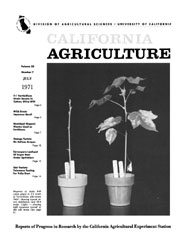


University of California
California Agriculture
|
|||
|
|||

Cover:
Response of Acala 4-42 cotton plants to T-1 strain of Verticillium albo-atrum
(left) - showing typical severe defoliation - and SS-4 strain (right) - showing mild symptoms typical of this wilt strain.
July 1971
Volume 25, Number 7 |
|||
|
University of California, 1301 S. 46th St., Bldg. 478 Richmond, CA
|